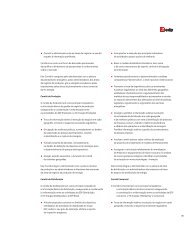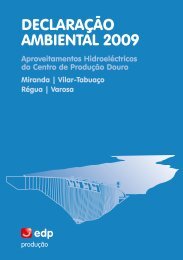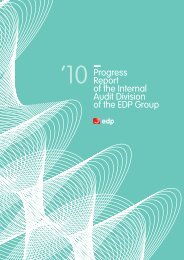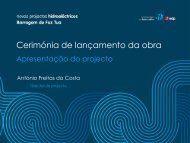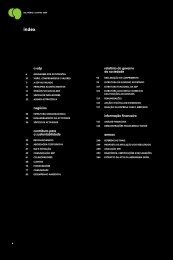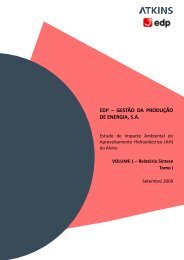notes to the <strong>EDP</strong> consolidated - Energias de Portugal, and company S.A. financial statementsNotes to for the the Consolidated years and ended Company 31 december Financial Statements 2012 and 2011for the years ended 31 December 2012 and 2011Goodwill impairment test analysis – <strong>EDP</strong> GroupThe recoverable amount of the goodwill in subsidiaries is assessed annually, as at 30 September, independently of the existence of any indicators of impairment.Impairment losses are recognised in the income statement. The recoverable amount is determined based on the value in use of the assets, calculated using valuationmethodologies supported by discounted cash flow techniques, considering market conditions, the time value of money and the business risks.The recoverable amount testing is performed for each cash flow generating unit, identified in each country where <strong>EDP</strong> Group develops its activities/operations,namely: HC Energia (including Naturgás) - Generation, Distribution & supply of electricity and Distribution & supply of gas; <strong>EDP</strong> Renováveis Europe – Wind generation; <strong>EDP</strong> Renováveis North America and Brasil - Wind generation; <strong>EDP</strong> Brasil - Generation, Distribution, and supply.Therefore, for the purposes of these tests, the <strong>EDP</strong> Group has defined a set of assumptions to determine the recoverable amount of the main investments of the Group.Goodwill impairment test analysis – HC Energia Group (including Naturgás)The discount rates after taxes used by the Group in the impairment test analysis range between 6.77% and 7.47% (2011: between 6.3% and 7.2% respectively).Regarding to generation business the future cash flow projection corresponds to the remaining useful life of the respective assets (power plans). In the electricity andgas transmission business the cash flow projection period considered was five years added by a growth rate, since long-term contracts exists. Remaining businessesestimated curves prices for the reference periods.The main assumptions on which impairment tests are based are as follows:- In the generation business, the estimated energy produced by the power plants: consider the best estimate of future market demand and total installed capacity;- Prices of electricity, gas and coal were defined considering the market expectations regarding future price curves and considering the regulation in force. Contractedprices for future long term purchases were also used;- Investment costs: the best available estimates of the future investments were used in order to guarantee a regular use of existing assets, as well as the estimatesthat resulted from legislative changes;- Operating costs: Operating costs were projected consistent with the company’s experience and internal models;- The growth rates used to make projections for the electricity and gas generation and supply assets is zero. However, for the electricity and gas distribution businessis used 1% of the growth rate. These growth rates are based on the market growth and inflation expectations;- In the regulated business, namely distribution of electricity and gas, officially approved asset remuneration was used, considering the regulated mechanisms for theannual remuneration updates;- Discount rate: the discount rates used reflect <strong>EDP</strong> Group’s best estimate regarding the specific risks associated to each CGU.The Group has performed a series of sensitivity analyses to the results of impairment tests in some key variables, such as (i) pool price; (ii) cost of fuel (iii) discount rates;and (iv) trade energy. The sensitivity analysis results show that (i) a 5% decrease on the pool price or in trade energy ; or (ii) a 5% increase in the fuel costs; or (iii) a+100bps increase on the discount rate do not result in any impairment indicators.Goodwill impairment test analysis – <strong>EDP</strong> RenováveisThe future cash flows projection used is the useful life of the assets (25 years) which is consistent with the current depreciation method. This projection also incorporatethe long-term off-take contract in place and long-term estimates of energy prices, whenever the asset holds merchant exposure.The main assumptions used for the impairment tests are as follows:- Power produced: net capacity factors used for each CGU utilize the wind studies carried out, which takes into account the long-term predictability of wind output andthat wind generation is supported in nearly all countries by regulatory mechanisms that allow for production and priority dispatching whenever weather conditionspermit;- Electricity remuneration: regulated or contracted remuneration has been applied where available, as for the CGUs that benefit from regulated remuneration or thathave signed contracts to sell their output during all or part of their useful life; where this is not available, prices were derived using price curves projected by thecompany based on its experience, internal models and using external data references;- New capacity: tests were based on the best information available on the wind farms expected to be built in coming years, adjusted by probability of success and bythe growth prospects of the company based on the Business Plan Targets, its historical growth and market size projections. The tests considered the contracted andexpected prices to buy turbines from various suppliers;- Operating costs: established contracts for land leases and maintenance agreements were used; other operating costs were projected consistent with the company’sexperience and internal models;- Terminal value: considered as a 15% of the initial investment in each wind farm, considering inflation;<strong>EDP</strong> - <strong>Annual</strong> <strong>Report</strong> 2012209
notes to the consolidated <strong>EDP</strong> - and Energias company de Portugal, financial S.A. statementsfor the Notes years to the ended Consolidated 31 december and Company 2012 Financial and Statements 2011for the years ended 31 December 2012 and 2011- Discount rate: the discount rates used are post-tax, reflect <strong>EDP</strong>R Group’s best estimate of the risks specific to each CGU and range as follows:20. INVESTMENTS IN SUBSIDIARIES (COMPANY BASIS)This caption is analysed as follows:2012 2011Portugal and Spain 7.0% - 7.1% 6.7%United States 5.5% - 6.8% 5.0% - 6.9%Rest of Europe 5.9% - 8.2% 6.0% - 8.6%Impairment tests done have taken into account the regulation changes in each country, as disclosed in note 1.Were performed a series of sensitivity analyses of the results of impairment tests to reasonable changes in some of the key variables, such as:- <strong>EDP</strong>R NA, decrease in the Net Capacity Factors of 2.1%;- <strong>EDP</strong>R NA, 10% reduction of Merchant Prices;- <strong>EDP</strong>R EU, decrease of the terminal value until 10%.Furthermore, <strong>EDP</strong>R Group has done an additional sensitivity analysis increasing 100 basis points the discount rate used in case base for <strong>EDP</strong>R NA and <strong>EDP</strong>R EU CGU's.These sensitivity analyses performed for each assumption independently would not suppose any impairment for the goodwill allocated to each country.Goodwill impairment test analysis – <strong>EDP</strong> BrasilFor <strong>EDP</strong> Brasil, the cash flows were determined based on the production and consumption volume and estimated tariffs and installed capacity and tariff evolutionprospects in the different markets / power purchase agreements. The period of considered cash flows corresponds to the useful life of the plant & machinery andother relevant equipments or until the end of the concession contracts, if lower than the useful life.The discount rate used of 8.05% in 2011 (8.3% in 2011), reflects the Group’s best estimate regarding the specific risks related to each CGU.The terminal value of the distribution business corresponds to the present value of the assets and the end of the concession period (Regulatory Asset Base). In thegeneration / supply business, the terminal value corresponds to the present value of the assets net of amortisation at the end of the concession period.This sensitivity analysis of considering +100bps on the discount rate does not result in any impairment indicators for "goodwill".CompanyThousands of Euros Dec 2012 Dec 2011Acquisition cost 11,012,092 10,863,358Effect of equity method (transition to IFRS) -902,524 -1,020,632Equity investments in subsidiaries 10,109,568 9,842,726Impairment losses on equity investments in subsidiaries -200,034 -133,9439,909,534 9,708,783On the date of transition to IFRS, <strong>EDP</strong>, S.A. ceased to apply the equity method of accounting to its investments in its unconsolidated financial statements, havingconsidered this method in the determination of the deemed cost at transition date.Investments in subsidiaries are analysed as follows:CompanyDec 2012 Dec 2011Thousands of Euros Net amount Net amountInvestments in subsidiaries:<strong>EDP</strong> Renováveis S.A. 2,939,889 2,939,889<strong>EDP</strong> Gestão de Produção de Energia, S.A. 2,156,054 2,156,054Hidroeléctrica del Cantábrico, S.A. 1,981,798 1,981,798<strong>EDP</strong> Distribuição de Energia, S.A. 1,686,145 1,686,145<strong>EDP</strong> Servicios Financieros España, S.A. 482,695 481,695<strong>EDP</strong> Investments and Services, S.L. 281,854 -<strong>EDP</strong> Comercial, S.A. 238,473 188,463<strong>EDP</strong> Energias do Brasil, S.A. - 193,909Other 142,626 80,8309,909,534 9,708,783The variation in the caption Investments in subsidiaries on a company basis (200,751 thousands of Euros) results, essentially, from the share capital increase of <strong>EDP</strong>Investments and Services, S.L. realised through a contribution in kind of 11.23% of the share voting rights over <strong>EDP</strong> Energias do Brasil (net effect of 87,945 thousands ofEuros), from the supplementary capital conceded to <strong>EDP</strong> Imobiliária e Participações, S.A. (65,000 thousands of Euros), <strong>EDP</strong> Comercial, S.A. (50,000 thousands of Euros)and <strong>EDP</strong> Serviços - Sistemas para a Qualidade e Eficiência Energética, S.A. (50,000 thousands of Euros) and from the impairment losses on equity investments in <strong>EDP</strong>Imobiliária e Participações, S.A. (65,000 thousands of Euros).In August 2012, the shares that <strong>EDP</strong>, S.A. held on <strong>EDP</strong> Energias do Brasil, S.A., corresponding to 53,482,659 ordinary shares, representing 11.23% of the voting rights, inthe amount of 193,909 thousands of Euros was used to subscribe a share capital increase in <strong>EDP</strong> Investments and Services, S.L., through a contribution in kind of thereferred shares, evaluated in 281,854 thousands of Euros, having been recognised a gain on the financial statements of <strong>EDP</strong>, S.A. in the amount of 87,945 thousandsof Euros (see note 14).210A World Full Of Energy
- Page 1:
Impresso em papel elaborado com cel
- Page 6 and 7:
: edp :index6 edp6 message to share
- Page 8 and 9:
: edp :EDP - Annual Report 20127
- Page 10 and 11:
Portugalrenewablesgás7,194 Employe
- Page 12 and 13:
: edp :1.1.3. CORPORATEBODIESboard
- Page 14 and 15:
: edp :1.1.5. principles ofsustaina
- Page 16 and 17:
: edp :BRAzILEDP Brasil distinguish
- Page 18 and 19:
: edp :1.3.2. Operating HighlightsU
- Page 20:
: edp :1.3.5. ENVIRONMENT INDICATOR
- Page 24 and 25:
: edp :strategicframeworkxxxxxxxxxx
- Page 26 and 27:
: strategic framework :Reconversion
- Page 28 and 29:
: strategic framework :EVOLUTION OF
- Page 30 and 31:
: strategic framework :million at D
- Page 32 and 33:
: strategic framework :Since 2005,
- Page 34:
: strategic framework :EDP - Annual
- Page 38 and 39:
: a edp :performance38 business40 I
- Page 40 and 41:
: performance :EDP - Annual Report
- Page 42 and 43:
: performance :By the end of the ye
- Page 44 and 45:
: performance :electricity generati
- Page 46 and 47:
: performance :EDP Distribuição h
- Page 48 and 49:
: performance :electricity AND GAS
- Page 50 and 51:
: performance :Despite the increase
- Page 52 and 53:
: performance :electricity supply i
- Page 54 and 55:
: performance :In 2012, EDPR increa
- Page 56 and 57:
: performance :3.1.3. EDP BRAsILEDP
- Page 58 and 59:
: performance :EDP brasilGENERATION
- Page 60 and 61:
: performance :Distribution of comp
- Page 62 and 63:
: performance :testing the adherenc
- Page 64 and 65:
: performance :3.4.1. managementsys
- Page 66 and 67:
: performance :In Brazil, EDP has n
- Page 68 and 69:
: performance :that 117 m 3 of oil
- Page 70 and 71:
: performance :EDP has undertaken t
- Page 72 and 73:
: performance :encourages professio
- Page 74 and 75:
: performance :The set of indicator
- Page 76 and 77:
: performance :Voice of the custome
- Page 78 and 79:
: performance :(ACAPO), are also av
- Page 80 and 81:
: performance :3.7. suppliersThe pe
- Page 82 and 83:
: performance :Transparency; Leader
- Page 84 and 85:
: performance :The following table
- Page 86:
: performance :between the local au
- Page 90 and 91:
: a edp :Corporate governance89 sta
- Page 92 and 93:
: corporate governance :STATEMENT O
- Page 94 and 95:
: corporate governance :STATEMENT O
- Page 96 and 97:
: corporate governance :I. GENERALM
- Page 98 and 99:
: corporate governance :In all othe
- Page 100 and 101:
: corporate governance :II.1.1. Cor
- Page 102 and 103:
: corporate governance :The company
- Page 104 and 105:
: corporate governance :Strategy Co
- Page 106 and 107:
: corporate governance :Companies C
- Page 108 and 109:
: corporate governance :From 22 Feb
- Page 110 and 111:
: corporate governance :The Institu
- Page 112 and 113:
: corporate governance :Careers, Mo
- Page 114 and 115:
: corporate governance :Commercial
- Page 116 and 117:
: corporate governance :Corporate S
- Page 118 and 119:
: corporate governance :new matters
- Page 120 and 121:
: corporate governance :with the Eu
- Page 122 and 123:
: corporate governance :unavailabil
- Page 124 and 125:
: corporate governance :in share ca
- Page 126 and 127:
: corporate governance :II.19. Posi
- Page 128 and 129:
: corporate governance :II.26. Rule
- Page 130 and 131:
: corporate governance :II.28. Posi
- Page 132 and 133:
: corporate governance :Executive B
- Page 134 and 135:
: corporate governance :EDP has no
- Page 136 and 137:
: corporate governance :CHAPTER III
- Page 138 and 139:
: corporate governance :III.3. Hold
- Page 140 and 141:
: corporate governance :Share price
- Page 142 and 143:
: corporate governance :Capital Mar
- Page 144 and 145:
: corporate governance :III.13. Int
- Page 146 and 147:
: corporate governance :In 2012, th
- Page 151 and 152:
EDP Renováveis opensfirst wind far
- Page 153 and 154:
: financial report :5.1. edp group
- Page 155 and 156:
: financial report :these impacts,
- Page 157 and 158:
: financial report :local currency,
- Page 159 and 160: : financial report :amount of EUR 1
- Page 161 and 162: : financial report :EDP - Energias
- Page 163 and 164: : financial report :EDP - Energias
- Page 165 and 166: : financial report :EDP - Energias
- Page 167 and 168: : financial report :EDP - Energias
- Page 169 and 170: : financial report :EDP - Energias
- Page 171 and 172: 12.pdf 1 02/04/13 14:50notes to the
- Page 173 and 174: notes to the consolidated EDP and -
- Page 175 and 176: notes to the consolidated EDP and -
- Page 177 and 178: notes to the consolidated and compa
- Page 179 and 180: notes to the consolidated EDP and -
- Page 181 and 182: notes to the consolidated EDP and -
- Page 183 and 184: notes to the consolidated EDP and -
- Page 185 and 186: notes to the consolidated EDP and -
- Page 187 and 188: notes to the consolidated EDP and -
- Page 189 and 190: notes to the consolidated EDP and -
- Page 191 and 192: notes to the consolidated EDP and -
- Page 193 and 194: notes to the consolidated EDP - and
- Page 195 and 196: notes to the consolidated EDP and -
- Page 197 and 198: notes to the consolidated EDP - and
- Page 199 and 200: notes to the consolidated EDP - and
- Page 201 and 202: notes to the consolidated EDP - and
- Page 203 and 204: notes to the consolidated EDP and -
- Page 205 and 206: notes to the consolidated EDP - and
- Page 207 and 208: notes to the consolidated EDP - and
- Page 209: notes to the consolidated and compa
- Page 213 and 214: notes to the consolidated EDP - and
- Page 215 and 216: notes to the consolidated EDP - and
- Page 217 and 218: notes to the consolidated EDP - and
- Page 219 and 220: notes to the consolidated EDP and -
- Page 221 and 222: notes to the consolidated EDP and -
- Page 223 and 224: notes to the consolidated EDP - and
- Page 225 and 226: notes to the consolidated EDP - and
- Page 227 and 228: notes to the consolidated EDP - and
- Page 229 and 230: notes to the consolidated EDP - and
- Page 231 and 232: notes to the consolidated EDP and -
- Page 233 and 234: notes to the consolidated EDP - and
- Page 235 and 236: notes to the consolidated EDP and -
- Page 237 and 238: notes to the consolidated EDP - and
- Page 239 and 240: notes to the consolidated EDP - and
- Page 241 and 242: notes to the consolidated EDP - and
- Page 243 and 244: notes to the consolidated EDP - and
- Page 245 and 246: EDP - Energias de Portugal, S.A.Not
- Page 247 and 248: notes to the consolidated EDP - and
- Page 249 and 250: notes to the consolidated EDP and -
- Page 251 and 252: notes to the consolidatedEDPand- En
- Page 253 and 254: notes to the consolidated EDP - and
- Page 255 and 256: notes to the consolidated EDP and -
- Page 257 and 258: notes to the consolidated and compa
- Page 259 and 260: notes to the consolidated and compa
- Page 261 and 262:
notes to the consolidated and compa
- Page 263 and 264:
notes to the consolidated and compa
- Page 265 and 266:
notes to the consolidated and compa
- Page 269 and 270:
Hydroelectric powerplant of Bempost
- Page 271 and 272:
: annexes :annexesannex Ifinal refe
- Page 273 and 274:
: annexes :by Instituto Superior de
- Page 275 and 276:
: annexes :Chairman of Euronext Lis
- Page 277 and 278:
: annexes :basis. He was designated
- Page 279 and 280:
: annexes :annex IIItransactions pe
- Page 281 and 282:
: annexes :EDP’s material issues
- Page 283 and 284:
: annexes :Simultaneously, the foll
- Page 285 and 286:
: annexes :GRI complianceThis repor
- Page 287 and 288:
: annexes :286A World Full Of Energ
- Page 289 and 290:
: annexes :288A World Full Of Energ
- Page 291 and 292:
: annexes :290A World Full Of Energ
- Page 293 and 294:
: annexes :292A World Full Of Energ
- Page 295 and 296:
: annexes :294A World Full Of Energ
- Page 297 and 298:
: annexes :296A World Full Of Energ
- Page 299 and 300:
: annexes :298A World Full Of Energ
- Page 301 and 302:
: annexes :300A World Full Of Energ
- Page 303 and 304:
: annexes :302A World Full Of Energ
- Page 305 and 306:
: annexes :304A World Full Of Energ








